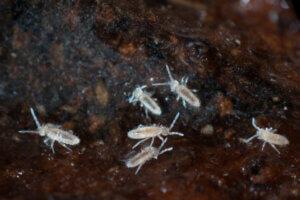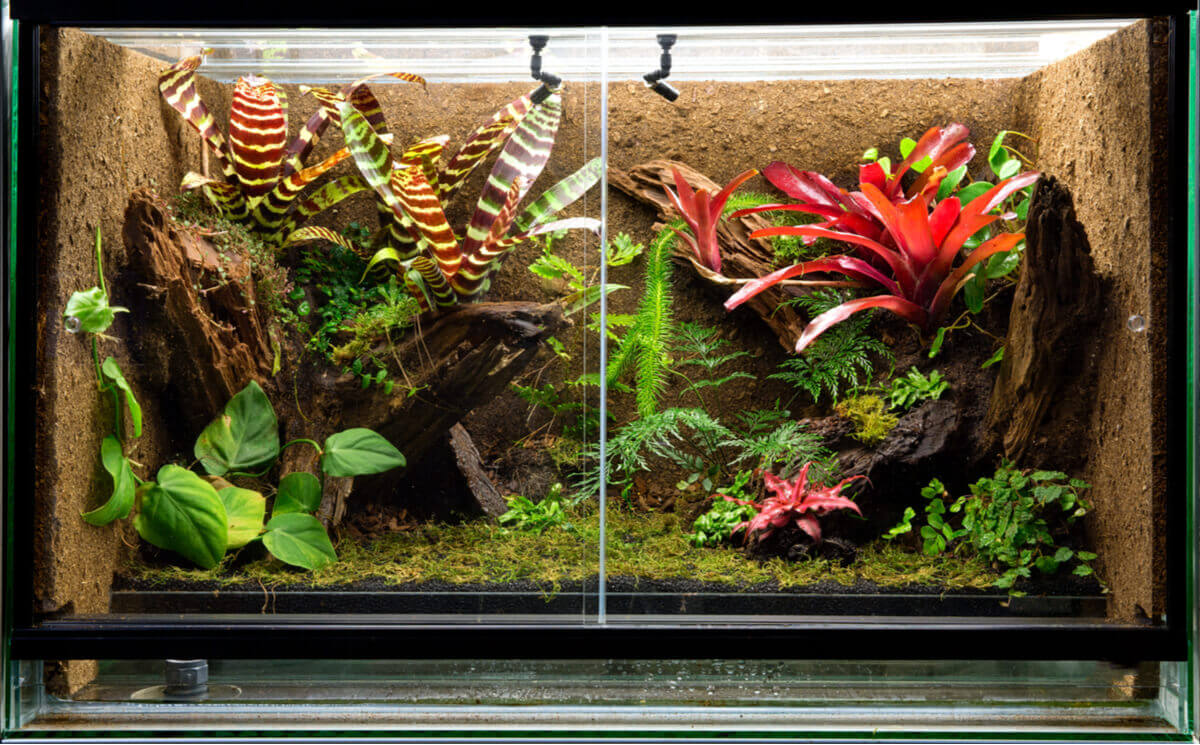How Do Springtails Help Clean Terrariums?


Written and verified by the biologist Ana Díaz Maqueda
Springtails (subclass Collembola) are animals that belong to the order of hexapods, that is, they share a taxon with insects. The main difference between them is that insects develop wings, while springtails don’t. However, the latter also have three pairs of legs.
These tiny beings help clean terrariums and are excellent at what they do. What’s more, they’re easy to breed and will help to keep the artificial ecosystem cleaner. Therefore, the animals that live there, such as reptiles or amphibians, will be healthier. In the following article, we’ll show you how these small arthropods can help clean terrariums.
Why do springtails keep help clean terrariums?
In nature, springtails have colonized the entire world, including Antarctica. There are more than 7,000 known species, so there’s a wide variety of them that can go well in different types of terrariums.
It would be rare for a person to have a terrarium set in a frozen ecosystem. However, for the most common types of vivariums, such as tropical, temperate, and dry ones, there’s a wide variety of springtails that will act as a natural cleaning group.
Whatever the type of terrarium, these animals have a very specific place in the food chain, playing the part of detritivores. The diet of these arthropods is based on dead organic matter, among which we find the following elements:
- Remains of food that reptiles or amphibians have left behind, whether of plant or animal origin
- Dead leaves, branches, and roots inside the terrarium that have started the degradation process
- Feces of the animals living in the terrarium

Finally, springtails also feed on fungi. In temperate terrariums – but especially in humid ones – many fungi proliferate that could become a serious problem for the health of the animals. These small invertebrates are avid fungi eaters and will keep them at bay. Therefore, the terrarium will need less frequent cleaning.
When there aren’t enough fungi to feed on, the springtails will base their diet on mold. Mold can occur in any terrarium and can sometimes cause respiratory diseases in pets, so eliminating it is essential.
How to breed terrarium cleaners?
Breeding springtails is easy, as they reproduce quickly and require little more than a damp place to hide if needed. Even so, you should bear in mind that these arthropods can be a pest for any pots in your house. Seal your growing facility and the terrariums where you’re going to add them well.
Sometimes springtails damage the roots of plants. However, this shouldn’t be a concern inside a terrarium, as they’ll have other foods to eat.
Springtails are easily available in specialist stores and on the internet. When they arrive, you can put them directly into the terrarium next to the wet piece of cardboard or charcoal that they’re usually transported with.
Once inside the terrarium, springtails usually need a few days to settle in. But they’ll soon be looking for food on the substrate and getting rid of the annoying mold and pet waste.
It doesn’t hurt to feed the springtails sporadically. Sometimes the amount of waste isn’t enough to feed the colony, so putting in some 100% pure brewer’s yeast is a good idea.
Other people decide to purchase a culture and develop the colony in a separate facility. This is as simple as putting solid charcoal in a plastic container with holes in the lid for ventilation and filling it half full of water. The charcoal provides the springtails with necessary organic matter, while the evaporating water provides a moist environment.
How to remove springtails from a terrarium?
Sometimes the atmosphere in the terrarium is so favorable that springtails grow too quickly and could be a problem for the balance of the ecosystem. At this point, it’s very complicated – or almost impossible – to remove the animals by hand.
Therefore, if this problem arises, there are different actions you can take:
- Stop feeding the springtails extra food.
- Empty the terrarium of decorations and animals. Then, add some water and turn the terrarium so that all the water collects in one corner. Springtails float, so it’s easy to catch them.
- Don’t confuse springtails with mites that are harmful to your pets. Springtails jump and are elongated, while mites move slowly and are circular in shape.

Springtails (subclass Collembola) are animals that belong to the order of hexapods, that is, they share a taxon with insects. The main difference between them is that insects develop wings, while springtails don’t. However, the latter also have three pairs of legs.
These tiny beings help clean terrariums and are excellent at what they do. What’s more, they’re easy to breed and will help to keep the artificial ecosystem cleaner. Therefore, the animals that live there, such as reptiles or amphibians, will be healthier. In the following article, we’ll show you how these small arthropods can help clean terrariums.
Why do springtails keep help clean terrariums?
In nature, springtails have colonized the entire world, including Antarctica. There are more than 7,000 known species, so there’s a wide variety of them that can go well in different types of terrariums.
It would be rare for a person to have a terrarium set in a frozen ecosystem. However, for the most common types of vivariums, such as tropical, temperate, and dry ones, there’s a wide variety of springtails that will act as a natural cleaning group.
Whatever the type of terrarium, these animals have a very specific place in the food chain, playing the part of detritivores. The diet of these arthropods is based on dead organic matter, among which we find the following elements:
- Remains of food that reptiles or amphibians have left behind, whether of plant or animal origin
- Dead leaves, branches, and roots inside the terrarium that have started the degradation process
- Feces of the animals living in the terrarium

Finally, springtails also feed on fungi. In temperate terrariums – but especially in humid ones – many fungi proliferate that could become a serious problem for the health of the animals. These small invertebrates are avid fungi eaters and will keep them at bay. Therefore, the terrarium will need less frequent cleaning.
When there aren’t enough fungi to feed on, the springtails will base their diet on mold. Mold can occur in any terrarium and can sometimes cause respiratory diseases in pets, so eliminating it is essential.
How to breed terrarium cleaners?
Breeding springtails is easy, as they reproduce quickly and require little more than a damp place to hide if needed. Even so, you should bear in mind that these arthropods can be a pest for any pots in your house. Seal your growing facility and the terrariums where you’re going to add them well.
Sometimes springtails damage the roots of plants. However, this shouldn’t be a concern inside a terrarium, as they’ll have other foods to eat.
Springtails are easily available in specialist stores and on the internet. When they arrive, you can put them directly into the terrarium next to the wet piece of cardboard or charcoal that they’re usually transported with.
Once inside the terrarium, springtails usually need a few days to settle in. But they’ll soon be looking for food on the substrate and getting rid of the annoying mold and pet waste.
It doesn’t hurt to feed the springtails sporadically. Sometimes the amount of waste isn’t enough to feed the colony, so putting in some 100% pure brewer’s yeast is a good idea.
Other people decide to purchase a culture and develop the colony in a separate facility. This is as simple as putting solid charcoal in a plastic container with holes in the lid for ventilation and filling it half full of water. The charcoal provides the springtails with necessary organic matter, while the evaporating water provides a moist environment.
How to remove springtails from a terrarium?
Sometimes the atmosphere in the terrarium is so favorable that springtails grow too quickly and could be a problem for the balance of the ecosystem. At this point, it’s very complicated – or almost impossible – to remove the animals by hand.
Therefore, if this problem arises, there are different actions you can take:
- Stop feeding the springtails extra food.
- Empty the terrarium of decorations and animals. Then, add some water and turn the terrarium so that all the water collects in one corner. Springtails float, so it’s easy to catch them.
- Don’t confuse springtails with mites that are harmful to your pets. Springtails jump and are elongated, while mites move slowly and are circular in shape.

All cited sources were thoroughly reviewed by our team to ensure their quality, reliability, currency, and validity. The bibliography of this article was considered reliable and of academic or scientific accuracy.
- Dányi, L. (2011). Cave dwelling springtails (Collembola) of Hungary: a review. Soil Organisms, 83(3), 419-432.
- Hopkin, S. P. (1997). Biology of the springtails:(Insecta: Collembola). OUP Oxford.
- Shrubovych, J. (2002). The fauna of springtails (Collembola) in Lviv. Вестник зоологии.
- Unknonw. (2019). A straightforward guide for breeding Folsomia candida Springtails. New England Herpetoculture LLC. Disponible en: https://www.neherpetoculture.com/springtailcare
This text is provided for informational purposes only and does not replace consultation with a professional. If in doubt, consult your specialist.








